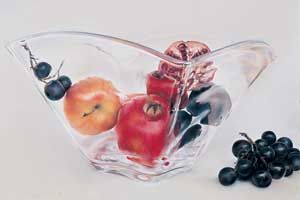
By Devon Jackson
It wasn’t until Sonya Fairbanks had given up on art entirely that she finally became an artist. Her end, and her beginning, came in 1995. She’d been working days as a preparator for SITE Santa Fe, the leading nonprofit modern-art space in Santa Fe, NM, and had just finished installing a show. Exhausted and frustrated after almost 10 years of trying to make it as an artist, 10 years of waitressing and bartending and restaurant managing, she’d had it. So she had a talk with God. I give up, she said. I’m gonna let it go. But if it’s a usable talent for the world, then give me a job.
“I felt like I’d been moving further and further away from society, from what I wanted to be doing,” recalls Fairbanks. “Basically, I let go completely.” Then, maybe two weeks later, the owner of Pranzo, a popular Italian restaurant in Santa Fe where she’d been waiting tables, came up to her and said, “I’ve seen some of your drawings. Would you design some for the restaurant?” While most people would’ve taken that as a sign, as proof of God’s existence, or God’s grace, or at least would’ve immediately responded with a secularly emphatic “Boy, howdy!”—Fairbanks equivocated. Sure, she’d always drawn, and drawn well, but the requested still lifes weren’t her thing. She was more into photography and conceptual art, not the literal, not the banal. She didn’t want to be known as a still-life painter, she told a friend. Who then told Fairbanks, “If you can draw like this, you should. Besides, Picasso designed an airplane, and that’s not on his resume.” Convinced, she did the drawings.
And she more or less hasn’t looked back since. “Now I see it as a blessing and a really good lesson,” concedes Fairbanks, who thought she’d hop right back into her conceptual work. That hasn’t exactly happened, but Fairbanks is OK with that, too. “The limitation of still life has forced me to look at a new kind of freedom. My philosophy now is, your work is to be of service. Artists should feel a sense of purpose. It’s a gift you’re given and it’s a job. You do this, you do the other [conceptual] stuff, you do both.”
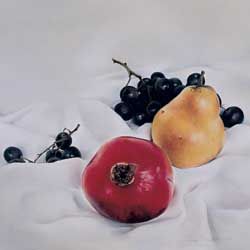 A self-described oddball while growing up on the beaches of Santa Barbara, CA, where she was born, Fairbanks was as much nurtured by nature as she was destined to draw. The daughter of a poet mom and electrical engineer dad, she and her two older brothers (one who later earned a doctorate in botany, the other a doctorate in behavioral ecology) were exposed to the outdoors early and often, with family hikes to Yosemite, Big Sur, Carmel, all over California.
A self-described oddball while growing up on the beaches of Santa Barbara, CA, where she was born, Fairbanks was as much nurtured by nature as she was destined to draw. The daughter of a poet mom and electrical engineer dad, she and her two older brothers (one who later earned a doctorate in botany, the other a doctorate in behavioral ecology) were exposed to the outdoors early and often, with family hikes to Yosemite, Big Sur, Carmel, all over California.
Fairbanks remembers becoming excited at seeing a Monet painting as early as kindergarten. And even though she told her mom at age 5 that she wanted to become an artist, her parents and teachers envisioned for her a life as a concert pianist. She played along, until a meltdown at a competition at 14 convinced her folks otherwise. “I just couldn’t go on,” admits Fairbanks. “I had terrible stage fright.” Fortunately, her parents let her quit the stage for the studio. She went at art with a vengeance. By the time she started college, she’d blown through her high school’s art curriculum and had already accumulated about 30 units’ worth of credits at the local junior college, mostly in technique, figurative drawing, and color theory.
As much as she’d learned in school, however, she didn’t experience art’s intensity firsthand until a close encounter with a Mark Rothko painting. “I just stood in front of it and started bawling,” says Fairbanks of that fateful junior-year moment in New York. “Something about his work just hit me and thrilled me. That this painting, this art, had this ability to be ecstatic and to go beyond the intellectual and into emotion. It was very powerful. And I got more interested in trying to capture that same effect.”
After graduating from the University of California at Santa Barbara in 1988 with a degree in photography, she got into printmaking, narrative pieces, SITE Santa Fe, and restaurants. Despite a long-lasting relationship with painter-professor Ciel Bergman, first as a student and then as a friend, Fairbanks had a thing, a stigma, against painting. And as helpful as SITE was, it could also be misleading. “A lot of the artists there had received grants for what they were doing, and so they tended to make it all look so easy,” she laments. “Which could be a little discouraging.”
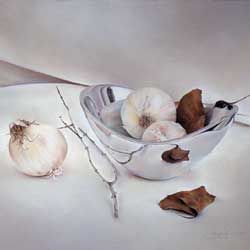 But then came the Pranzo drawings, executed in chalk pastels, which is now her preferred medium. “It’s very hard to make it look realistic using the chalk, and it takes a lot of time and a lot of layering,” explains Fairbanks, who spends about 100 hours on each drawing. “But I wanted the drawings to be under glass so they wouldn’t be damaged by food. And I’ve just stuck with them.”
But then came the Pranzo drawings, executed in chalk pastels, which is now her preferred medium. “It’s very hard to make it look realistic using the chalk, and it takes a lot of time and a lot of layering,” explains Fairbanks, who spends about 100 hours on each drawing. “But I wanted the drawings to be under glass so they wouldn’t be damaged by food. And I’ve just stuck with them.”
Now 37 and back in Santa Barbara after nearly a decade in Santa Fe, Fairbanks acknowledges that oil would be an easier medium; it’s very forgiving, more amenable to being scraped off and started over. But Fairbanks has come to appreciate pastel’s demands, the mindfulness it requires—for planning, for taking care what she’s doing, where she’s going. “I like being forced to leave it as it is. It stems from my interest in Zen philosophy, or maybe from my German past,” she reasons.
She also finds the whole process very meditative, and not without a certain contradiction: In college she’d been working on a series of 6-foot color-montage photographs, causing her photo instructor to remark, “It seems like you’re wanting to be a painter.” “Ironically,” chuckles Fairbanks, “now my paintings look like photographs!”
She hasn’t given up on conceptual work, or for that matter oil, altogether—she’s just approaching it in her own way. Lately, she’s been exploring the insides of fruit with an arthroscopic camera (the kind used by orthopedic surgeons) and coming up with colorgraphic oil paintings of seeds. “What people call me—a contemporary realist—is not exactly what I would call myself, given these other projects I’ve been doing,” offers Fairbanks.
Not so surprisingly, it’s photographers she feels the closest affinity to—in particular, to James Balog, whose stark studio portraits of near-extinct animals often remind her of her still lifes. “They’re bright, and they’re light to the point where there’s no shadow, so they have this timeless, spaceless quality,” Fairbanks says of Balog’s work. “Plus, the subjects have been taken out of their normal context, which I also like to do. And we still see their vulnerability and their beauty.”
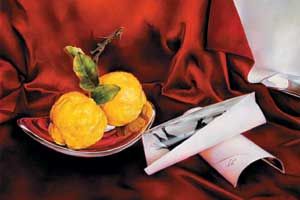 People, surmises Fairbanks, seek out still lifes for the familiar, for the humble and the elevated. “We’re just as vulnerable as this little piece of fruit. It’s a reminder of where we are in the end,” she muses. “We want the heroic in art, but we’re not separate or greater than. When you focus on this humble little world of fruit and vegetables, you can relate it to everything.”
People, surmises Fairbanks, seek out still lifes for the familiar, for the humble and the elevated. “We’re just as vulnerable as this little piece of fruit. It’s a reminder of where we are in the end,” she muses. “We want the heroic in art, but we’re not separate or greater than. When you focus on this humble little world of fruit and vegetables, you can relate it to everything.”
Fairbanks also relates to photographer Duane Michals (“For the way he talks about very serious things but in really playful ways”), to painter Francesco Clemente, to Chilean-born still-life master Claudio Bravo, and to Santa Fe icon Georgia O’Keeffe, who also held her subjects in high regard. Like O’Keeffe, and unlike the still lifes of Cézanne or Wayne Thiebaud, Fairbanks’ fruits are all about the fruit and little else. Her works are reverential, almost religious, most definitely spiritual.
“Still life’s gotten such a bad rap. It’s been associated with the humble, with the feminine, with the vulnerable, as if all those are inherently bad qualities,” Fairbanks says almost forlornly. “We focus so much on having stuff and not appreciating it. I’ve learned the appreciative part by painting so slowly. But it takes a lot of focus and a lot of love. Anyone can paint still lifes. But you have to be willing to go through the pains of getting to know it.”
A formalist who prefers flat things with very little dimension, Fairbanks works from both photographs and the real thing. She spends a tremendous amount of time setting up—a half-inch turn in any direction, and the reflection of the light changes dramatically. And although she sees only out of one eye, having been born sort of cross-eyed, Fairbanks considers her “defect” an asset. “It’s easier to paint realism, realistically, with one eye,” she claims. “I’m not translating three-dimensional to two-dimensional. So it’s less complex to me. Plus, the way I see color, it comes in clearer through my left eye.”
Because fruit tends to decay pretty fast (and because she sometimes eats her subjects), Fairbanks knows, and works, when things are in season—and has mastered the Latin names of all the local flora and fauna. “It’s partly practical,” says the artist, who lives in a farming community just outside Santa Barbara, in a small house with a big studio. “If a client wants a pomegranate painting in May, I tell them they’ll have to wait.”
Subtly, she’s begun working into her pastels elements symbolic of her past. In two recent pieces, the LAST DANCE and SUNDAY AT FIVE IN THE AFTERNOON (after the Federico Garcia Lorca poem), she included curled-up pictures of bullfights. She got the photographs at a flea market while visiting Spain last year. Sensing a connection between bullfighting and flamenco, Fairbanks noticed a curling movement that women flamenco dancers make with their hands. She asked a dancer if the woman was portraying the bull. Yes, said the woman. So Fairbanks decided to use the bullfighting photos in her pastels: the matador being culture, the bull being nature or the feminine. Because people usually went to the bullfights right after church, Fairbanks interpreted this as people wanting to see culture dominate nature. And if the bull wins, they not only kill the bull, they kill the bull’s mother, too, Fairbanks alludes. They kill the feminine either way. “So I’m making my own very subtle statement with these curled-up pictures of bullfights,” she asserts. “It draws you in with beauty to make this statement about what culture does to nature. It’s more of me in the work.”
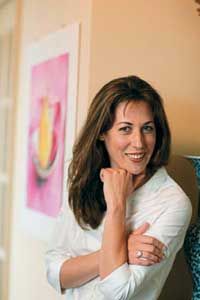 Just as subtle has been her incorporation of glass and metal objects into her still lifes—with all their distortions and reflections, all that syrupy dreaminess against so much crisp exactitude. “In my symbolic universe, this distorted image, often quite beautiful and mysterious,” philosophizes Fairbanks, “represents the sacred, ineffable parts of life.” Or taken a step further, one could surmise that all of it, the highly realistic, the distorted reflections, everything that is seen is merely a reflection; possibly a reflection of a greater reality. Or maybe not. Maybe it’s just a bowl of fruit.
Just as subtle has been her incorporation of glass and metal objects into her still lifes—with all their distortions and reflections, all that syrupy dreaminess against so much crisp exactitude. “In my symbolic universe, this distorted image, often quite beautiful and mysterious,” philosophizes Fairbanks, “represents the sacred, ineffable parts of life.” Or taken a step further, one could surmise that all of it, the highly realistic, the distorted reflections, everything that is seen is merely a reflection; possibly a reflection of a greater reality. Or maybe not. Maybe it’s just a bowl of fruit.
Fairbanks is represented by Easton Gallery, Santa Barbara, CA; Victoria Boyce Galleries, Scottsdale, AZ; and Meyer-Munson Gallery, Santa Fe, NM.
Featured in January 2005





